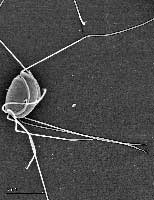
Spironucleus vortens
The comparative genomic study of basal eukaryotes affords a unique perspective on the origins and evolution of core features of eukaryotic cells, such as the nucleus and cytoskeleton. Phylogenomic analysis of basal eukaryotic groups makes possible the construction of an evolutionary “map” of the key events in eukaryote evolution, such as the elaboration of various components of the cytoskeleton. The molecular and cellular analysis of a wider phylogenetic range of organisms, particularly basal eukaryotes, could challenge conventional assumptions about the “homology” of various eukaryote features, such as the mechanism of mitosis or cytoskeletal function. With few exceptions, the overwhelming majority of existing microbial eukaryotic genome projects are of parasites. However, axenically cultivated (i.e., grown without other living organisms) free-living relatives of many parasitic groups are available for genomic investigations. Two such basal eukaryotes are the amitochondriate Spironucleus vortens (diplomonad) and the free-living amoeba-flagellate Naegleria gruberi (valkamphid). The JGI will produce an 8X draft-quality genome sequence of Spironucleus vortens, and to facilitate genomic comparisons of the amitochondriates, a 2X draft sequence of Naegleria gruberi. Each represents a “kingdom-level” eukaryotic group. Beyond the cytoskeleton, genomic studies will provide key insights into the spliceosome, the proteosome, protein trafficking, cell cycle regulation, and other major features of eukaryotes. Genomic data will provide an intellectual groundwork for subsequent empirical determinations of protein function in basal eukaryotic model organisms like Giardia intestinalis. Importantly, sequenced genomes will expedite future proteomic and functional analysis of diverse free-living eukaryotes.
CSP project participants: W. Zacheus Cande (proposer, Univ. of California, Berkeley).